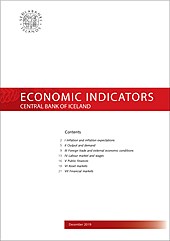
Gunnar Jakobsson appointed Deputy Governor for Financial Stability
Prime Minister Katrín Jakobsdóttir has appointed Gunnar Jakobsson to the position of Deputy Governor for Financial Stability. Gunnar Jakobsson has a degree in Law and an MBA from Yale University. In recent years he has held executive positions with Goldman Sachs, first in New York, and more recently as Managing Director of Liquidity and Personal Data Protection with Goldman Sachs International in London.
 More
More

Minutes of the MPC
Here are the minutes of the Monetary Policy Committee of the Central Bank of Iceland from the meeting held on 9 and 10 December 2019. There, the Committee discussed economic and financial market developments, the interest rate decision on 11 December, and the communication of that decision.
 More
More

Economic Indicators 20 December 2019
The Central Bank of Iceland’s Economic Indicators report for December 2019 has been released and can be found here on the Bank’s website. The publication contains information on developments in prices, output, external trade, the labour market, public sector finances, asset markets, and the financial market. The information is published in chart form, and underlying data can be called up in spreadsheet format.
 More
More

IMF issues annual Article IV report on Iceland
The Executive Board of the International Monetary Fund concluded its 2019 Article IV consultation with Iceland today, 19 December. The IMF holds similar consultations with member countries every one to two years on the basis of Article IV of the IMF‘s Articles of Agreement. A Selected Issues Paper on the Scope for Improving Iceland‘s Fiscal Framework accompanied the main report. The Executive Board concluded its consultation on a lapse-of-time basis without convening formal discussions. An IMF Mission was in Iceland in November to consult with the Icelandic authorities and other stakeholders.
 More
More

New version of the Central Bank of Iceland‘s Quarterly Macroeconomic Model
The Central Bank‘s Quarterly Macroeconomic Model (QMM) has served as the Bank‘s main tool for forecasting and macroeconomic analysis since its implementation in 2006. The model is revised regularly and the Economic and Monetary Policy Division has recently completed a major revision with the new version used for the first time for forecasting in November 2019. The QMM Handbook has been revised and version 4.0 is now available on the Bank’s website.
 More
More